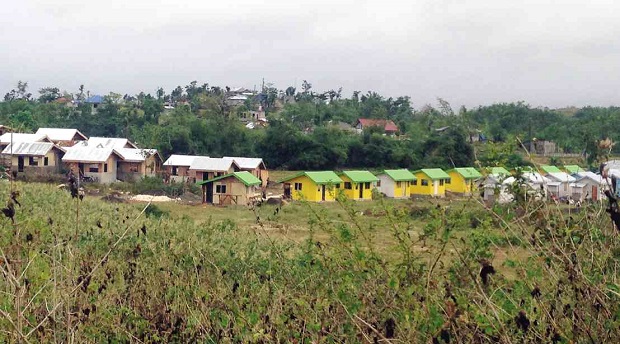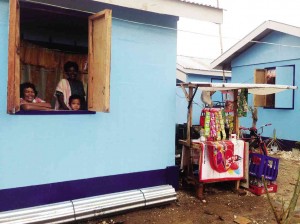With homelessness, trauma lingers

THE YOLANDA Village in Barangay La Paz, Bogo City, now has 40 houses. The village plans to build 116 houses on the 1-hectare lot provided by the city government. PHOTO BY Carmel Loise Matus
(First of three parts)
Five months after Supertyphoon “Yolanda” flattened his house, fisherman Danilo Chavez still lives in a shanty assembled from salvaged galvanized iron sheets and bamboo poles.
“The heat from the iron roof and wall becomes unbearable during daytime. When it rains, water comes in,” he said.
The ramshackle dwelling is 150 meters from where his house had stood along the coast of Barangay Talotu-an on Pan de Azucar Island in Concepcion town, Iloilo province.
Chavez, a 53-year-old father of eight children, said he could not afford to build another house. “If only the government can help us,” he muttered.
Article continues after this advertisementWith the loss of homes come feelings of fear and paranoia and lack of sense of community among the displaced.
Article continues after this advertisementDr. June Pagaduan Lopez of Citizens’ Network for Psychosocial Response said the feelings surfaced when her group conducted a needs and resource mapping in Barangay San Jose in Tacloban City and Palo town, both in Leyte province.
Lopez, a trauma expert and among the top psychiatrists in the country, said the storm survivors had been living in fear since losing their homes. Whenever the wind howls or storm signals are raised, they get scared, she said.
Corazon Pilones is hoping for help from the national government so she could have her hut repaired in Gibitngil, an island-village in Medellin town in northern Cebu province. Yolanda blew off the nipa-thatched roof of the hut and broke down its bamboo walls on Nov. 8 last year.
Pilones, her husband Henry and their 4-year-old son and 2-year-old daughter are still staying in the hut, topped this time with tarpaulin sheets given by nongovernment organizations (NGOs).
Chavez and Pilones are among the millions of typhoon survivors who are awaiting housing assistance from the national government.
Devastation figures
Yolanda (international name: Haiyan), the strongest recorded typhoon to hit land with winds reaching 300 kilometers per hour, devastated wide areas mostly in the Visayas. It left 6,268 people dead and 28,689 injured, while at least 1,061 remained missing, according to a March 14 report of the National Disaster Risk Reduction and Management Council.
A total of 1,034,518 houses were destroyed or damaged in the Visayas, according to the Department of Social Welfare and Development (DSWD).

LORNA AMBOS is all smiles in her new house in Yolanda Village in Barangay La Paz, Bogo City. PHOTO BY Carmel Loise Matus
The figure included 512,324 in Western Visayas (303,266 damaged and 209,058 destroyed), 420,197 in Eastern Visayas (200,340 damaged and 219,857 destroyed) and 101,997 in Central Visayas (54,207 damaged and 47,790 destroyed).
Social Welfare Secretary Corazon “Dinky” Soliman met with the survivors of Estancia town in Iloilo on Dec. 4 last year and assured them of assistance from the national government. She was accompanied by Interior Secretary Manuel “Mar” Roxas II and Defense Secretary Voltaire Gazmin.
Soliman had said the government would provide construction materials worth P30,000 to owners of destroyed houses and P10,000 for damaged ones.
After the reports of affected houses are validated by the DSWD, the survivors would be given assistance through the Department of Public Works and Highways (DPWH), according to the secretary.
On March 30, Senate President Franklin Drilon said in an interview that Congress had already appropriated P60 billion this year for rehabilitation programs and projects, including housing assistance for the survivors. He said it would be up to the executive branch to release the funds and implement the programs and projects.
No fund releases
But many are asking where the promised assistance is.
As of April 1, survivors and local government executives said no funds for housing had been released.
Evelyn Macapobre, DSWD director for Western Visayas, said her office had already completed the validation of beneficiaries of housing aid, but Edilberto Tayao, DPWH director for the region, said the mechanics for its release and implementation had not been finalized. “We are waiting for guidelines from our national office,” Tayao said.
Lopez said the homeless survivors were feeling the uncertainty of being given a permanent relocation site. As a result, they do not trust their barangay officials because they are afraid of being taken out of the list of housing beneficiaries.
Lopez said the community spirit was also absent due to competition among neighbors on who would get priority in the relocation plan.
Since they don’t have permanent homes, the survivors are not motivated to do anything in the community because they feel they are there temporarily, she said.
“How can you rehabilitate when you have that mentality?” she asked.
Self-reliance
A few have been fortunate to acquire new houses or tarpaulin sheets from international and local NGOs and humanitarian groups. Many, however, have been forced to fend for themselves by sifting usable materials from debris or borrowing money to buy nails, bamboo or plywood, nipa palm leaves and GI sheets.
Monica Cabantug of Barangay Cagay in Roxas City, Capiz province, said she was able to borrow P7,000 from a lending company for the repair of her house and reconnection of power supply. She must pay P375 weekly for up to 25 weeks, or a total of P9,375 (with 33.92-percent interest), to the firm.
Many of her neighbors have also borrowed money from the company.
In the case of Pilones, she and her husband Henry do not have money for house repair. They have been relying on food relief from the DSWD.
Henry could earn only P200 a week from fishing. He used to earn P100 a day, but fish catch has dropped since Yolanda. Medellin Mayor Ricardo Ramirez surmised that the corals near Gibitngil Island might have been damaged during the typhoon, resulting in the dwindling fish haul.
Many other residents in Barangay Gibitngil are waiting for help. Almost half of the village’s 403 houses were destroyed and the other half, damaged.
Extra jobs, extra cash
In Barangay Talotu-an in Concepcion, Iloilo, Brenda Batsar has been offering laundry services to augment her family’s income. The 43-year-old woman said she wanted to help her husband and son, both fishermen.
Yolanda’s winds blew away their house on a hilly area. They survived by seeking cover under salvaged GI sheets placed on top of branches of a fallen mango tree.
Batsar broke into tears when she recalled their ordeal, but she said what was important was that they were unharmed.
Like many survivors, her family has been living in a makeshift dwelling put up from debris.
Her husband and son were among the beneficiaries of fishing boats donated by the civic group One Meal and the Honolulu-based Consuelo Foundation. Still, their earnings are barely enough to buy food and other necessities, Batsar said.
Many of her neighbors also need housing assistance.
Of the 688 houses in Talotu-an, 477 were destroyed and the rest were damaged, according to village chief Leo Ferraris. With a report from Connie E. Fernandez